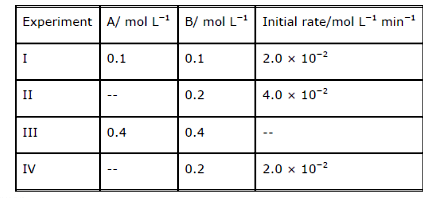The reaction between A and B is 1st order w.r.t to A and zero order w.r.t B. Find the value of [A] and rate as per the following blanks
![The reaction between A and B is 1^(st) order w.r.t to A and zero order w.r.t B. Find the value of [A] and rate as per the following blanks](https://d10lpgp6xz60nq.cloudfront.net/physics_images/VMC_CHE_WOR_BOK_04_C18_E01_023_Q01.png)
Rate =k[A]1[B]0
Exp. 1: 2×10−2=k(0.1)1[0.1]0
k=0.2 m in−1
Exp. 2: 4×10−2=0.2[A][0.2]0
[A]=0.2 mol L−1
Exp. 3 : Rate =0.2×0.4=0.08 mol L−1 m in−1
Ex. 4 : 2×10−2=0.8[A]=0.1 mol L−1
Topper's Solved these Questions
- CHEMICAL KINETICS BOOK - VMC MODULES ENGLISHCHAPTER - CHEMICAL KINETICS EXERCISE - Level-1
75 Videos
- CHEMICAL KINETICS BOOK - VMC MODULES ENGLISHCHAPTER - CHEMICAL KINETICS EXERCISE - Level-2
50 Videos
- CHEMICAL KINETICS BOOK - VMC MODULES ENGLISHCHAPTER - CHEMICAL KINETICS EXERCISE - Level-0 (Short Answer Type-II )
6 Videos
- CHEMICAL EQUILIBRIUMBOOK - VMC MODULES ENGLISHCHAPTER - CHEMICAL EQUILIBRIUMEXERCISE - IN-CHAPTER EXERCISE - G
10 Videos
- CHEMICAL THERMODYNAMICS BOOK - VMC MODULES ENGLISHCHAPTER - CHEMICAL THERMODYNAMICS EXERCISE - IN - CHAPTER EXERCISE - L
10 Videos
Similar Questions
The reaction between A and B is first order with respect to A and zero order with respect to B. Fill in the blanks in the following table:

View SolutionFind the odd one (w.r.t. photoperiod) from the following.
View SolutionIntegrate the following w.r.t x
1/x log x
View SolutionFor the non-equilibrium process, A+B→ Product, the rate is first-order w.r.t. A and second order w.r.t. B. If 1.0mol each of A and B were inrofuced into 1.0L vessel and the initial rate was 1.0×10−2molL−1s−1, calculate the rate when half the reactants have been turned into Products.
View SolutionFor the non-equilibrium process, A+B→ Product, the rate is first-order w.r.t. A and second order w.r.t. B. If 1.0mol each of A and B were inrofuced into 1.0L vessel and the initial rate was 1.0×10−2molL−1s−1, calculate the rate when half the reactants have been turned into Products.
View SolutionIntegrate the following w.r.t x
e2x+1
View SolutionFind the odd features w.r.t pinus.
View Solutionfind the odd one w.r.t. parasitism
View SolutionArrange the bones in ascending order w.r.t. length
View SolutionFind odd one w.r.t population
View Solution
